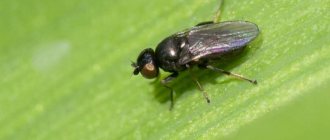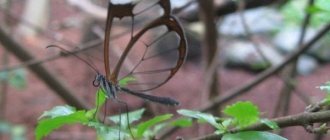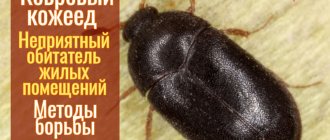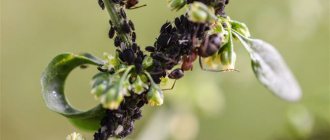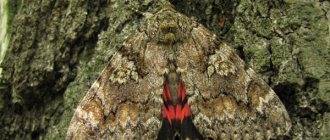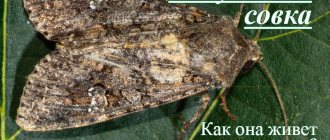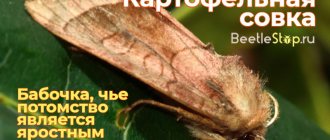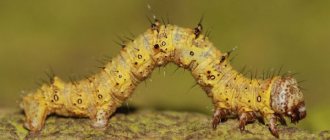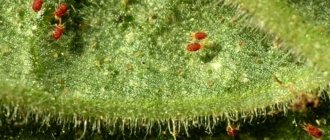What does a butterfly and moth caterpillar look like?
Cutworms damage the base of plants, as if “cutting them at the root,” and cause sudden wilting and death. The above-ground part remains untouched, but nothing connects it to the soil. In large plants, the base of the stem may be eaten away.
Gnawing cutworms include several types of noctules, the most common being the winter cutworm and the cutworm . The common external characteristics of these butterflies are a thick, hairy body, inconspicuous coloring, like a moth, thin antennae, two pairs of wings, which the butterfly folds horizontally when at rest.
Fall armyworm
Fall armyworm
The length of an adult is 18–22 mm, the wingspan is 35–45 mm. The forewings can be brown-gray, yellow-gray or almost black in color with a clear pattern of transverse stripes and three spots: round, kidney-shaped and wedge-shaped. The hind wings are gray-white with darkening along the outer edge and veins.
Cutworm caterpillar
The larvae of the winter armyworm are shiny, thick caterpillars up to 52 mm long, gray in color with a dirty green tint. Dark thin stripes run along the back and sides. To move, caterpillars have 8 pairs of legs.
Pupae 16–20 mm long are red in color with spines at the end of the abdomen.
exclamation scoop
Scoop exclamation
The butterfly is gray, brown, yellow-gray. Wingspan 35–40 mm. There are 3 dark spots visible on the fore wings.
The caterpillars grow to 30–50 mm and are dark gray in color. Their skin is matte, covered with large and small granular formations.
Pupa 17 mm long with yellow-brown integument.
In the Central region, in the northern and eastern regions, 1 generation of cutworms develops, in the south 2–3 generations appear.
The butterfly season begins in May-June. They are active at dusk and at night. They do not harm the plants themselves; they feed on nectar and participate in the pollination process.
On the underside of the leaves of weeds and cultivated plants, butterflies lay one or several white eggs. The fertility of females depends on the presence of flowering plants. On average, each female lays 400–500 eggs.
Depending on the air temperature, embryonic development lasts 3–24 days. The hatched caterpillars hide in cracks and under lumps of soil during the day, and crawl out to feed at night.
Agricultural technology comes to the rescue
Moth pupae overwinter in the ground at a maximum depth of 30 cm (certain species). In this regard, farmers recommend deep autumn (autumn) plowing of the plot. The activities carried out allow not only to clear the garden of weeds, but also to raise all the cutworm caterpillars to the surface. Methods to combat it do not end at this stage, since in the spring they organize additional digging of the site. In all cases, dug larvae die from frost or birds.
At the same time, when growing crops, they perform:
- deep loosening of row spacing during egg laying;
- removing weeds from the garden;
- mowing of vegetation along the perimeter of the territory.
The latter option is preventive, because the favorite “delicacy” of butterflies is nettle, pigweed and quinoa, the pollen of which they feed on. Therefore, if you remove these weeds from the site, the bats will look for new pastures for themselves and their offspring. In addition, the optimal conditions for caterpillar development are relative humidity of 50-80%. The permissible air temperature is about 15-25˚С.
“Perforated” leaves of vegetable crops will help determine the invasion of insect pests. The presence of holes and uneven edges are the first signs of the presence of “uninvited guests.”
Damage caused
Due to the gluttony of caterpillars, cutworms are classified as pests. First they eat the leaves of weeds, and then move on to cultivated plants. They gnaw through the stems and petioles at the root collar, and eat away the upper part of root crops.
Gnawing armyworms are polyphagous and harm more than 145 plant species. The caterpillars feed on grains and melons, potatoes, beets, corn, sunflowers, tomatoes, grapes, carrots, lettuce, etc. The pest overwinters in the soil as an adult caterpillar.
Folk remedies proven over centuries
Chemicals are not everyone's cup of tea. In this regard, many people successfully use herbal infusions to repel pests. These “potions” help get rid of voracious caterpillars. Hot pepper plays a special place in the destruction of armyworms.
The decoction is prepared according to this algorithm:
- add 100 g of pepper pods to 1 liter of water;
- the mass is boiled for 30-40 minutes;
- the cooled and strained liquid is brought to a volume of 9 liters.
The resulting product is sprayed on crop seedlings at different stages of the growing season. Onion infusion is also popular. Soak ½ part of a large chopped onion in a liter of water. Leave overnight and then filter through a thick layer of gauze. The area is treated during the active summer of the bats.
Wormwood has an excellent insecticidal effect. The stems and foliage of the plant (1 kg) are boiled for 15-20 minutes in 3 liters of water. The decoction is used cold for spraying seedlings.
Regardless of how to deal with the cutworm in the garden, the garden bed is always kept clean by removing weeds in a timely manner. In addition, the area is periodically loosened to provide oxygen to the plants and to undermine the caterpillars of lepidopteran insects.
How to get rid of cutworms
Chemical and biological drugs
Fury
Broad-spectrum insecticide. Protects plants for 25 days. Drug concentration: 1.5 ml per 10 liters of water. The maximum number of treatments during the season is no more than 2 times.
Proteus
A new systemic contact insecticide of combined action in the form of an oily dispersion. This allows the active components to quickly act on pests, penetrate inside the leaves, and not be washed off in the rain. The drug is recommended for use in the early stages - during the period of oviposition and the appearance of younger larvae.
7 ml of insecticide is poured into 3–5 liters of water, shake the solution well and spray the plants in dry and windless weather.
Biological products - gentle destruction
When deciding how to deal with cutworms in the garden, many farmers choose more humane methods. Farmers bring the trigram to the site, since the parasitic insects are known for their unusual way of laying embryos. Hymenoptera choose the eggs of harmful butterflies as a safe place for the embryo. Therefore, during the period of their activity (late May or early June), gardeners bring these “cleaners” to the site at the rate of 300-400 individuals per 1 sq.m.
Other farmers resort to biological preparations, among which are popular:
- Fitoverm (natural origin). Made from the active ingredient aversectin C, produced by soil microorganisms. 1 ampoule of the drug (2 ml) is diluted in 500 ml of water.
- Lepidocide. The bioinsecticide does not accumulate in plants or in soil. The consumption rate of the biological product is 20-30 g/10 l. When spraying cabbage, beets or carrots per 10 m², use 0.5-1 liters of working fluid. Repeated treatment is performed after 7-8 days.
- Bitoxibacillin. 40-80 g of the drug are diluted in 10 liters of liquid. Crops are sprayed when each generation of pests appears. In this case, an interval of 7-8 days is maintained. However, during the flowering period, dressing is prohibited.
After using biological products, gardening work begins after 10 days.
The given methods of combating cabbage cutworm will be effective if the treatment is carried out at air temperatures above 20˚C. Also, the weather should be calm and dry (no rain). The working fluid is prepared in the usual way. The required dosage of the drug is dissolved in a small amount of water. Stir thoroughly until the suspension or emulsion becomes homogeneous. Then the solution is brought to the required volume (10 l).
Preventive measures
To protect against pests:
- alternate cultures;
- do early plowing after collecting nitrogen-accumulating plants;
- garden crops are planted according to zones;
- clear the roadsides of dry grass;
- observe crop rotation;
- insects are treated taking into account the growing season;
- carry out autumn plowing;
- treat tubers before planting;
- destroy weeds;
- treat row spacing;
- loosen the ground.
Tips on folk remedies
To repel butterflies, you can spread or hang egg shells between beds of plants and rows .
Baits for catching adult cutworms are made from sweet drinks that can ferment. These include any syrups, molasses, kvass, juice, beer, liquid jam. Place the bait in small containers such as yogurt jars . Don't forget to remove any scoops you find.
Birds are very fond of cutworm larvae, so their attraction will significantly reduce pest populations. Flycatchers, titmice and sparrows are especially helpful . You can make feeders and nest boxes for them. Chickadees will be attracted to pieces of unsalted lard.
If you plant cilantro and basil next to possible victims, cutworms will not approach the plantings and will begin to fly around them, since they cannot stand the smell of these herbs.
Selecting a drug
In previous years, for each crop it was necessary to look for “its own” remedy or use toxic chemicals like DDT that would kill all living things.
Modern agrochemistry is following the difficult but necessary path of creating universal drugs to combat caterpillars. Caterpillars on coniferous trees, how to fight with folk remedies and medications, read more in this article.
For open ground
Modern insecticides can be used both for the garden and indoor soil. It is necessary to take into account the degree of damage by caterpillars and the type of crop. It is better to take funds that do not depend on weather conditions.
For garden
Preparations for caterpillars on trees are selected depending on the type of pest. Application method: spraying only. The toxicity class is taken into account so that bees are not harmed during the pollination period.
Caterpillars on viburnum: what to spray and how to fight the pest, read more in the article here.
For greenhouses and greenhouses
Suitable substances are those that can quickly evaporate or be washed away by rain in open areas. No such trouble is expected here. But we take into account the closed space and the danger of working in a high concentration of toxic chemical vapors.
For preventive treatments
To avoid caterpillar infestations, treat the area or greenhouse at the end of the season and before it begins. Spraying is combined with treatment of hard-to-reach places where the pest can lay eggs over the winter. Many people prefer folk remedies to chemicals - hot peppers, infusions of wormwood and celandine, soda solution.
Effective preparations and folk remedies for treating fruit trees against caterpillars
Proper selection and use of a remedy for caterpillars is half the success in the fight for the harvest. The sooner the pest is noticed, the fewer drugs are used, and, consequently, the cleaner both the crops and the soil will be.
